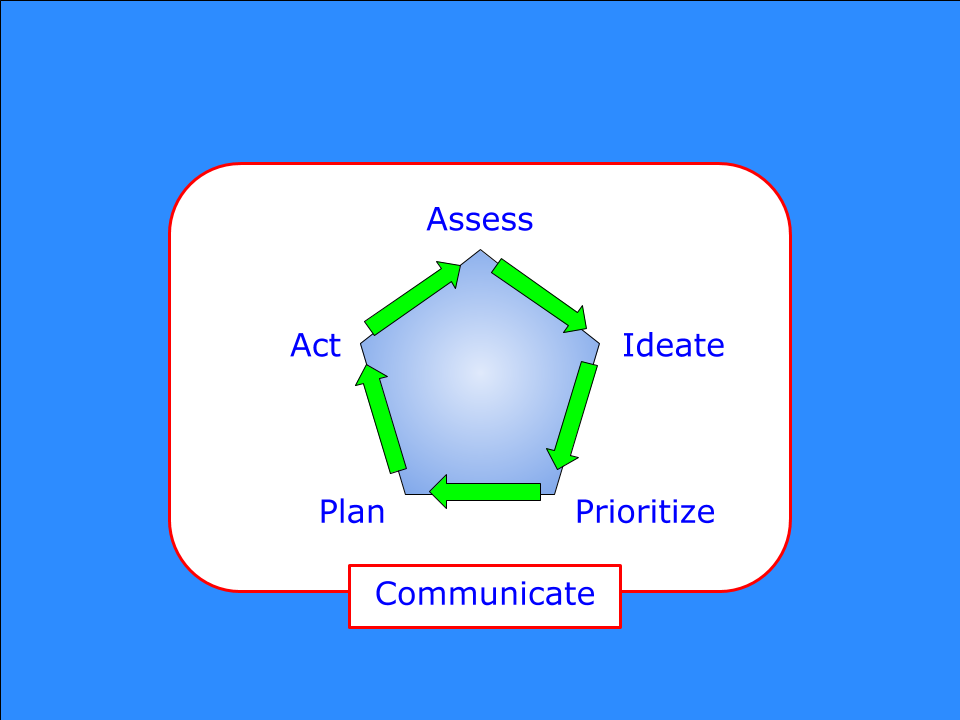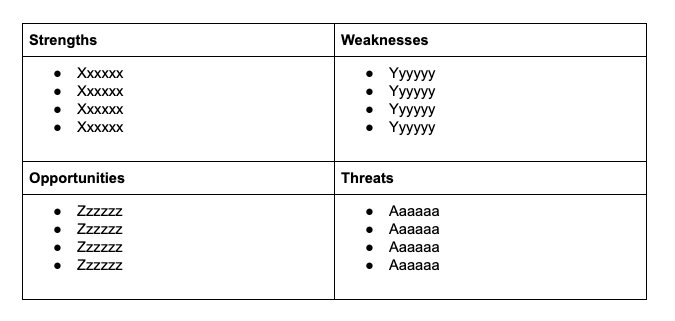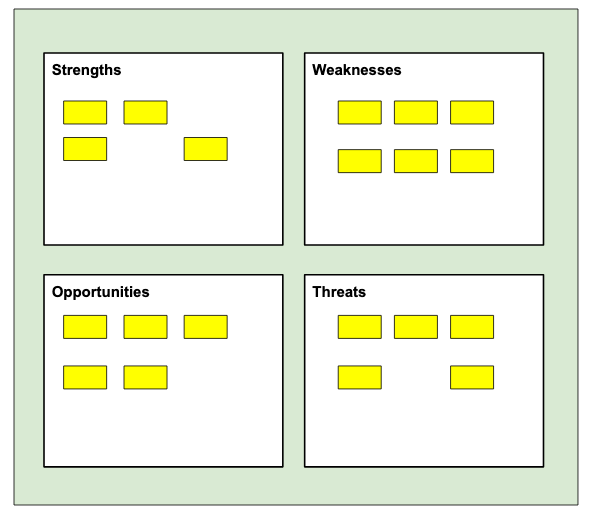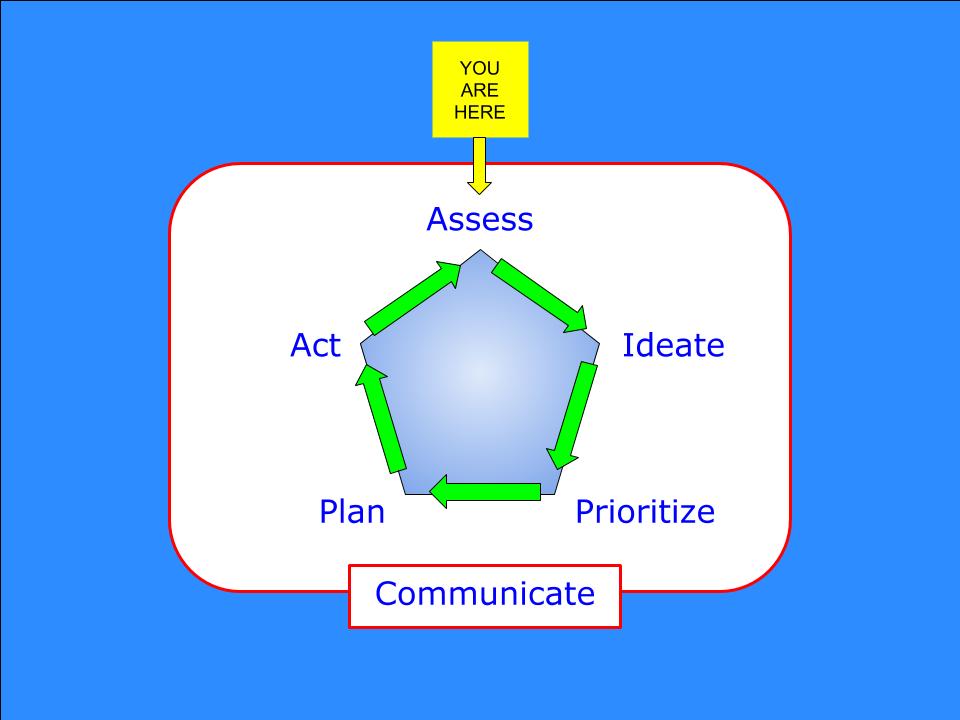Introduction
This is one in a series of articles about planning in uncertain times. In the first article, I introduced the framework – a repeatable cycle made up of six phases. The other articles are:
- Phase 1 – Assess – This article
- Phase 2 – Ideate
- Phase 3 – Prioritize
- Phase 4 – Plan
- Phase 5 – Act
- Phase 6 – Communicate

In this article we’ll explore the first phase: Assess. This is a set of critical activities performed at the beginning of the planning cycle. The objectives of the Assessment are:
- To identify a specific problem or opportunity that will need to be addressed in the future
- To develop a detailed view of your current state, and
- To determine which aspect of the current situation are relevant to addressing the future problem or opportunity.
Spending time and attention here will save time later and will help ensure that the later activities focus on the right problem and deliver appropriate results.
The Assessment Process
There are five steps in the Assessment Process:
- Define the Assessment Topic and Time Horizon
- Organize the Assessment Team
- Analyze the Current Situation
- Identify Relevant Ideas
- Communicate Status and Results
We will explore each step in turn below.
The Assessment will generate two outputs:
- A list of relevant ideas that will be the input in the next phase – Ideate.
- A communications agenda to inform key stakeholders about the results of the activity. (This output will be common across all phases.)
Define the Assessment Topic and Time Horizon
The assessment topic provides a focal point for all the activities in the planning cycle. It could be a problem, issue or opportunity that the business or organization is experiencing now or one that is anticipated in the future. Some examples are
- “How can we generate more revenue in our consulting business?”
- “What skills will we need in our workforce five years from now?”
- “How should our service offerings change after the COVID-19 pandemic?”
The time horizon is when you expect to need a solution or to take action.
If you are conducting an assessment for the first time, I suggest that you choose a simple topic with a short-term time horizon, like the next quarter or 6 – 12 months. This will allow you and your team to focus on learning the process. Later iterations can focus on more complex topics and can extend the time horizon to 12 – 18 months, 1 – 3 years, etc.
Some questions to ask yourself as you think about an Assessment topic are:
- What are the top 3 obstacles to delivering the results my organization expects?
- What questions keep me awake at night – the unknowns?
- What major challenges do I see in the months ahead?
By answering those questions, you will generate a list of preliminary topic ideas for further consideration. Review the list and determine which idea is most important. Eliminate any ideas where you already know the answer or the solution. Rank the remaining ideas by importance, urgency, potential risk or positive impact to your organization.
You’re going to invest significant time in the planning cycle, so be certain that the topic you select is worthy of your attention, and that of the team you organize. Otherwise, don’t spend too long making your decision. You will have additional opportunities to run the cycle in the future. Pick the topic that seems most important and move on.
Once you have selected the topic, restate it as a question.
Organize the Assessment Team
In order to get the maximum benefit from the analysis, you will need to identify a team of people who can help you look at the topic from a variety of angles. You want a team that brings multiple perspectives, with members who have experience or insight in the topic area and who can think clearly and imaginatively. Perhaps most important, you want team members who can challenge each others’ mindset and any prevailing assumptions about how things get done in your organization.
Think about people who have an interest in the outcome – your key stakeholders. These could be members of your staff or extended team, colleagues from other areas or trusted advisors. Consider including customers or suppliers if the topic impacts them.
Be selective in who you invite. Keep the team as small as possible while ensuring you have sufficient subject matter expertise. Limit the team to no more than ten people.
I suggest talking to each prospective team member individually. Explain to them that you are running a process to address a specific problem or opportunity and you would appreciate their help and input. Tell them the topic you have identified and why you think they could add value to the discussion. Be prepared to answer questions, particularly about the time commitment you’re asking them to make.
Consider giving each team member a homework assignment ahead of the first team meeting. This could be as simple as reading an article on the topic (that you provide). It could be more involved, like asking a person with specific expertise in a related area to prepare a briefing for the team on their area and how it impacts the topic.
You may also wish to identify a facilitator to assist you with the assessment and the Ideate phase that follows.
Finally, schedule time for an initial meeting of the team. The agenda should include:
- Introductions, particularly if not all team members know one another.
- An overview of the Assessment Topic, including your logic for selecting it.
- An overview of the Framework process, with specific attention paid to the Assess phase.
- Team norms. Consider drafting a set of team norms for the group to review and discuss. These are important to help the group feel comfortable challenging each others’ opinions.
- The schedule for future meetings and workshops.
- Q&A.
Analyze the Current Situation
With the topic identified and the team organized, we can now begin analyzing your current situation in detail. Given a clearly defined assessment topic, it will be tempting to jump in and immediately begin trying to solve the problem. Doing that will might result in an acceptable solution, but it may also be flawed by confirmation bias, or “the tendency to process information by looking for, or interpreting information that is consistent with one’s existing beliefs”. Quick solutions will reflect the limits of your team’s perspectives and your organization’s prevailing assumptions.
To avoid that bias we will use SWOT Analysis, a well-known tool that allows us to consider the topic from multiple perspectives, including some that may challenge our preconceived notions.
SWOT stands for Strengths, Weaknesses, Opportunities and Threats. This technique has been used for many years and is widely taught in business schools. It uses a structured approach to brainstorming that requires you to think about the assessment topic in the broader context of your organization and the external environment. You will approach the assessment topic by asking and answering questions about each of the four attributes:
- Strengths. These are your core competencies, the things that you do well, the assets or skills you have that give you a competitive advantage. They may also be proprietary technologies or specific process expertise.
- Weaknesses. These are the areas that can contribute to poor performance and may need to be addresses. They include obsolete equipment, outdated technology, heavy debt load and lack of expertise among employees.
- Opportunities. These are current or future conditions in the environment that you may be able to turn to your advantage. Some examples are changing population demographics, availability of talent in the marketplace, unmet customer needs and existing technologies or process knowledge that could be leveraged in other areas.
- Threats. These are conditions or events that can damage the organization. External threats may include pending legislation that has a negative impact, the emergence of new or stronger competitors, supply chain disruptions and natural disasters.
Strengths and weaknesses are usually thought of as internal – related to the organization – while opportunities and threats are usually considered to be related to the external environment. As you do the analysis, you may find items that cross the lines, like an opportunity to leverage an internal capability in new ways.
The output of the SWOT Analysis is often captured on a matrix, as shown below.

SWOT or TOWS?
As you are planning the SWOT analysis, you should determine the order that you will use to evaluate the four attributes – strengths, weaknesses, opportunities and threats. Michael Watkins, in his book The First 90 Days1, suggests doing it in reverse order – TOWS instead of SWOT. He recommends starting with the external environment – threats and opportunities – and then considering weaknesses and strengths. Watkins’ rationale is that the internal attributes should be assessed in relation to the external factors.
TOWS is a useful approach if your topic is more externally focused. It also helps focus the team’s attention on the external attributes early, when the team has more energy.
Answer the Questions
This is the heavy lifting part of the analysis. For each of the four attributes, you will review a list of questions and answer the ones that you think are appropriate to your situation. I’ve prepared an extensive list of questions that you can use as reference. The questions are prompts to make you think broadly about your current situation. Some examples are:
Strengths
- How do our customers and suppliers view our strengths? What do they say we do really well?
- Which of our products are especially innovative or market-leading?
- What special knowledge or skills do we possess?
Weaknesses
- In what areas do we know we need to improve?
- In what areas are our competitors better than us?
- What objections do we hear most often from potential customers?
Opportunities
- Is there a need in the market that we’re not meeting, but could?
- Do we have technologies or process knowledge that we could leverage in other areas?
- Are there opportunities arising from regulatory changes?
Threats
- Are our employees satisfied and engaged or do we face risk of attrition?
- What is the pandemic profile (infection rates, deaths) among our staff? Our communities?
- What happens if a manufacturer or supplier runs out of materials we need?
Some questions can be omitted, but carefully consider any you think you can skip. The question might actually be relevant if you think creatively about it. Also, by answering more questions you create a broader and more comprehensive perspective.
Remember: You are assessing your current state, not attempting to find solutions. If solution ideas are mentioned during the SWOT analysis, capture them separately. They can be reviewed during the Ideate phase that comes next.
Capturing the Answers
A common method for capturing answers and ideas is to create a large two by two matrix, on a whiteboard or flip chart (or in a spreadsheet or PowerPoint application if you’re doing this over Zoom). Label the four quadrants with the four attributes, as shown below. Alternately, you may prefer to simply create lists for each attribute. Don’t let the size of the matrix constrain your thinking!
Record the ideas from the team members for each attribute.. If you’re working in person, I suggest using sticky notes and putting those on the board. Doing it this way helps ensure that all participants’ ideas are captured. You don’t want to have a few very vocal members dominating the conversation. Using sticky notes will also help later, when you consolidate the ideas.

Consolidate and Clarify
Once you have captured the group’s answers for each of the four attributes, step back and review the ideas. Begin by looking at all of the ideas and eliminating any duplicates. If you find several ideas that are similar, consolidate them into a single statement.
Be alert for ideas that could cross boundaries or move into a different quadrant, if they were restated. For example, you might consider “employees’ resistance to change” as a weakness. But if you are operating in a highly regulated industry, or need to address inconsistent quality issues, you might value “rigorous process adherence” as a strength.
Finally, clarify the ideas. Restate each one to make it specific and fact-based. An example: Instead of “our debt ratio is manageable”, restate it as “our debt-to-equity ratio is 0.66, should not change significantly over the next 12 months, and is lower than the industry average”.
An Option to Consider
There is a complementary analysis technique that can be used to identify additional opportunities and threats. This technique is known as PEST, for Political, Economic, Social and Technological. If your assessment topic is largely external, you may wish to incorporate a PEST analysis in your SWOT. The format is very similar to that of a SWOT analysis, but the questions get into more detail about four areas: Political, Economic, Social and Technological. There are multiple variations of PEST, like PESTLE, which adds Legal and Environmental questions.
See the list of SWOT and PEST Analysis questions for additional details.
Identify the Relevant Ideas
The final step in the Assess phase is to identify the relevant ideas that address the assessment topic. During the SWOT analysis, you and your team generated a lot of different ideas. Not all of them will be applicable to the assessment topic, so you need to select the ideas that directly relate to the topic. You will identify the two or three most important ideas in each quadrant to take forward into the next steps of your planning process.
Review the list of ideas in each quadrant and test each one using a series of questions:
- Relevance: Does this idea address the topic? You may have identified strengths or weaknesses in your organization that are not directly related to the topic. So, while they are legitimate, they are not relevant to the topic being analyzed.
- Feasibility: Is this idea something that your organization can address, or should it be done by someone else? You don’t want to take on work that’s outside your scope.
- Timing: Can this idea be addressed within the time horizon? If you’re looking at a topic that needs to be addressed in the next 6 months, and the idea is only feasible in one to three years, then it’s not most important.
- Impact: What is the relative impact this idea have to the topic area? This can be either positive or negative. Rank it high, medium or low.
After doing those tests you should be able to identify the top two or three items in each of the quadrants. These will be inputs to the next phase – Ideate.
As you close out the SWOT analysis, take care to retain the lists of ideas and other materials generated during the discussion. You have completed a broad assessment of your organization’s current state. That work will be useful in other contexts, including the next iteration of the planning cycle.
Communicate Status and Results
You have a variety of stakeholders – employees, colleagues, your manager, other senior leaders, suppliers and possibly customers – who have different information needs and varying degrees of interest in your work. When deciding what to communicate to your stakeholders, it is important to realize that a “one size fits all” approach is not advisable.
Some stakeholders, particularly those directly impacted by the topic you have assessed, will need a detailed briefing on your assessment process and the outputs. Other stakeholders may only need a summary. With some stakeholders, you may want to solicit feedback, while with others you simply want to deliver a message.
The Assess phase has generated several important outputs that will be of interest to some of your stakeholders. These include the assessment topic, the SWOT and PEST analysis results and the list of relevant ideas for the Ideate phase.
The last step in the Assess phase is to communicate status and results, using the guidance published in the Communicate phase article. The Communicate phase contains six steps:
- Update your stakeholder analysis.
- Ask the six questions – Why? Who? What? How? Where? When?
- Update the communication plan.
- Create message triangles.
- Create the communication materials.
- Deliver the messages.
Conclusion
The Assess phase is a critical step in the planning cycle. By clearly defining your assessment topic, you narrow the focus of the activities to a specific problem, issue or opportunity. Organizing a well-balanced team to conduct the assessment will provide you with multiple points of view and insights. Utilizing the SWOT analysis techniques will give you a broad-based view of your current situation – your strengths, weaknesses, opportunities and threats – which will inform the Ideate activities that come next. The SWOT analysis output will also be a reusable basis for future iterations of the planning cycle.
In the next article, I will detail the Ideate phase. Until then, please let me know if you have questions about the Assess phase. You can always reach me by using the Contact Form.
To your success,


Join the discussion…
How do you conduct your planning activity? What has been your experience with SWOT Analysis?
Leave a comment below or send me a note using the Contact Form.
Footnotes
1 Michael Watkins, The First 90 Days: Proven Strategies for Getting Up to Speed Faster and Smarter (Boston, Harvard University Press, 2013), pp. 151-152.*
* This link is direct to Amazon.com. At the time of this writing (July, 2020), I receive no affiliate payment if you buy a copy. If that changes in the future, I’ll let you know.
